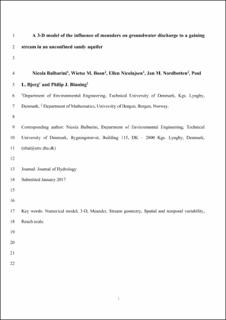| dc.contributor.author | Balbarini, Nicola | |
| dc.contributor.author | Boon, Wietse | |
| dc.contributor.author | Nicolajsen, Ellen | |
| dc.contributor.author | Nordbotten, Jan Martin | |
| dc.contributor.author | Bjerg, Poul L. | |
| dc.contributor.author | Binning, Philip J. | |
| dc.date.accessioned | 2022-01-11T09:49:58Z | |
| dc.date.available | 2022-01-11T09:49:58Z | |
| dc.date.issued | 2017 | |
| dc.identifier.issn | 0022-1694 | |
| dc.identifier.uri | https://hdl.handle.net/11250/2836848 | |
| dc.description.abstract | Groundwater discharge to streams depends on stream morphology and groundwater flow direction, but are not always well understood. Here a 3-D groundwater flow model is employed to investigate the impact of meandering stream geometries on groundwater discharge to streams in an unconfined and homogenous sandy aquifer at the reach scale (10–200 m). The effect of meander geometry was examined by considering three scenarios with varying stream sinuosity. The interaction with regional groundwater flow was examined for each scenario by considering three groundwater flow directions. The sensitivity of stream morphology and flow direction to other parameters was quantified by varying the stream width, the meander amplitude, the magnitude of the hydraulic gradient, the hydraulic conductivity, and the aquifer thickness. Implications for a real stream were then investigated by simulating groundwater flow to a stream at a field site located in Grindsted, Denmark. The simulation of multiple scenarios was made possible by the employment of a computationally efficient coordinate transform numerical method. Comparison of the scenarios showed that the geometry of meanders greatly affect the spatial distribution of groundwater flow to streams. The shallow part of the aquifer discharges to the outward pointing meanders, while deeper groundwater flows beneath the stream and enters from the opposite side. The balance between these two types of flow depends on the aquifer thickness and meander geometry. Regional groundwater flow can combine with the effect of stream meanders and can either enhance or smooth the effect of a meander bend, depending on the regional flow direction. Results from the Grindsted site model showed that real meander geometries had similar effects to those observed for the simpler sinuous streams, and showed that despite large temporal variations in stream discharge, the spatial pattern of flow is almost constant in time for a gaining stream. | en_US |
| dc.language.iso | eng | en_US |
| dc.publisher | Elsevier | en_US |
| dc.rights | Attribution-NonCommercial-NoDerivatives 4.0 Internasjonal | * |
| dc.rights.uri | http://creativecommons.org/licenses/by-nc-nd/4.0/deed.no | * |
| dc.title | A 3-D numerical model of the influence of meanders on groundwater discharge to a gaining stream in an unconfined sandy aquifer | en_US |
| dc.type | Journal article | en_US |
| dc.description.version | acceptedVersion | en_US |
| dc.rights.holder | Copyright 2017 Elsevier. | en_US |
| dc.identifier.doi | https://doi.org/10.1016/j.jhydrol.2017.06.042 | |
| dc.identifier.cristin | 1503811 | |
| dc.source.journal | Journal of Hydrology | en_US |
| dc.source.pagenumber | 168-181 | en_US |
| dc.identifier.citation | Journal of Hydrology. 2017, 552, 168-181. | en_US |
| dc.source.volume | 552 | en_US |

